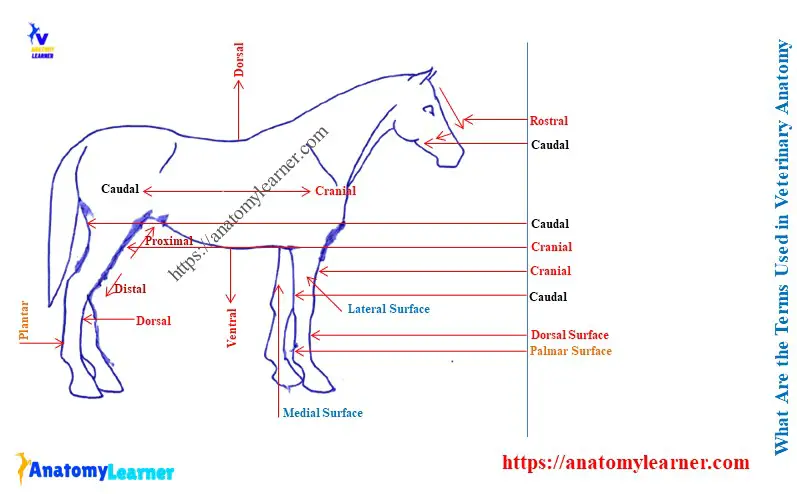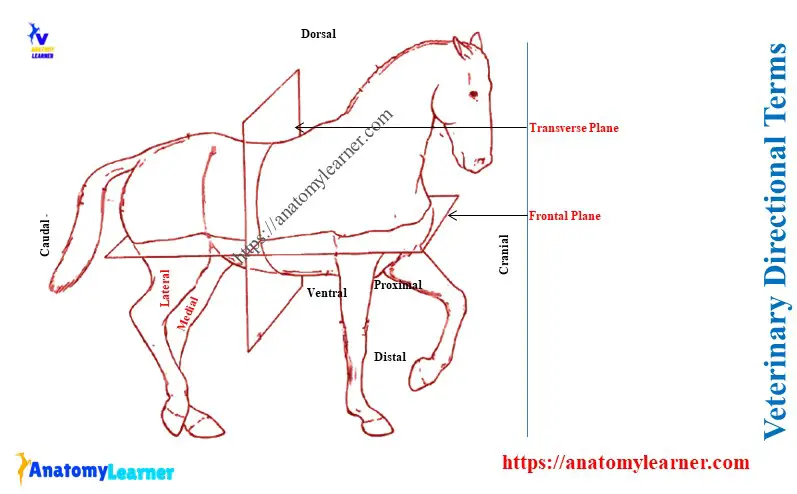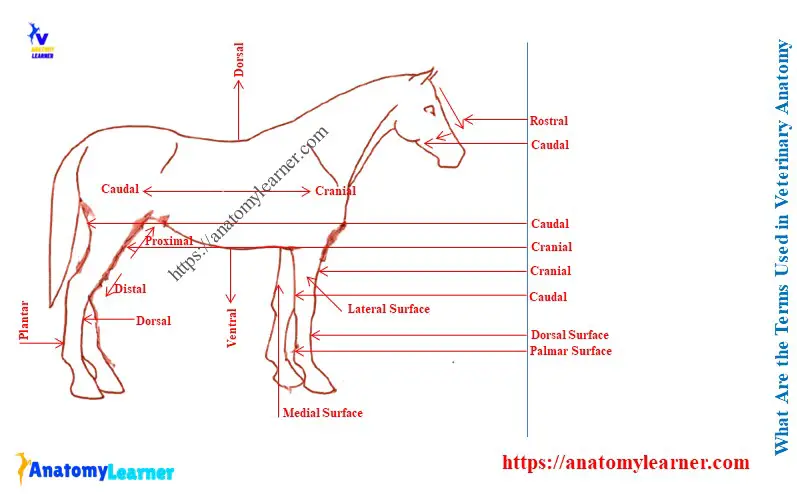The topographic and directional terminology are essential for beginner’s veterinary anatomy learners. Here, I will answer the question – ‘what are the terms used in veterinary anatomy?’ in detail.
Quick answer: dorsal, ventral, cranial, caudal, lateral, medial, superior, inferior, superficial, deep, proximal, distal, axial, abaxial, palmar, and plantar are the terms commonly used in veterinary anatomy. Again, longitudinal, sagittal, transverse, and frontal are veterinary anatomy’s most popular directional terms.
I will explain this topographic and directional terminology of veterinary anatomy with examples. So, let’s continue this article till the end to get an idea of the veterinary topographic and directional terms.
What are the terms used in veterinary anatomy?
Table 1 shows the terms used in veterinary anatomy –
| Veterinary anatomy terms | Meaning of the terminology |
| Ventral | Surface directed towards the plane of support (ground) |
| Dorsal | Opposite surface to the ventral (away from the ground) |
| Anterior | The front portion of the structure |
| Posterior | Related to the back portion |
| Lateral/external | Directed away from the median plane |
| Medial/internal | Surface directed towards the median plane |
| Superior | Related to the above portion of any structure |
| Inferior | Below area or part of any structure |
| Superficial | Close to the surface |
| Deep | Beneath the superficial |
| Proximal | Directed towards the body |
| Distal | Directed away from the animal’s body |
| Cranial | Towards the head end of an animal |
| Caudal | Towards the animal’s tail end |
| Rostal | Towards the nose of the animals |
| Axial | Towards the central line of the body or any part or structure |
| Abaxial | Away from the long axis of the body or any parts |
| Palmar | Forelimb surface that contacts the ground in standing condition |
| Plantar | Hind limb surface that contacts the ground in standing condition |
| Dorsal (in limbs) | The front side below the carpus and tarsus |
Here, the animal-labelled diagram shows the abovementioned terms (both topographic and directional). You will know more about these veterinary anatomy terms with actual examples.

What are the medical directional terms for animals?
There are four medical directional terms used for animals –
- Longitudinal median plane or vertical plane,
- Sagittal plane or paramedian plane,
- Transverse or segmental or cross-sectional plane, and
- Frontal or horizontal plane of the animal body,
Let’s see the summary of these four directional terms used for animals from Table 2 –
| Veterinary directional terms | Meaning of the directions |
| Longitudinal median plane | Divides the body into similar halves |
| Sagittal plane | Plane parallel to the longitudinal median plane |
| Transverse plane | Cut the long axis of the body perpendicular to the median plane |
| Frontal plane | Cut the long axis of the animal body horizontally |
Let’s describe the medical directional terms for animals with the labeled diagram.
Veterinary directional terms with diagrams
Longitudinal median plane: it is an imaginary plane passing through the animal’s body. The main characteristics features of the median plane of the animal body are –
- It passes through the mid-line of the body,
- It divides the animal body into similar halves (so that similar organs or structures are found in both halves),
Here, the diagram shows the longitudinal median plane of the animal body. It splits the animal body into similar halves.

Again, the diagram shows the longitudinal median plane from the bone of an animal. It also divides the bone into similar halves.
Sagittal plane of the animal body: the plane parallels the longitudinal median plane. But, it does not divide the body or structures into similar halves.
Sometimes, the median plane is known as the midsagittal plane of the animal body. Again, the sagittal plane other than the median plane is the paramedian plane.
The diagram shows the sagittal plane from the animal body and the bone.
Transverse and Frontal Plane of Animals
Transverse plane of the animal body: At the right angle of the median plane, it divides the body into cranial and caudal parts. A cross-section of the body or limb of any animal would be made on the transverse plane.
Here, the diagram shows the transverse plane from the animal body and limb bones.

Frontal plane of the animal body: it is the plane that is perpendicular to both the median and transverse planes. So, the frontal plane (horizontal) with the long axis shows the following features –
- It divides the animal body into dorsal and ventral portions, and
- The plane is parallel to the ground,
The diagram shows the frontal plane of the animal body that divides into upper and lower segments.
Now, you will easily understand all the topographic terms used in veterinary anatomy.
What are ventral and dorsal in veterinary terms?
The ventral surface is away from the vertebral column or towards the midabdominal wall. Thus, this surface of the animal body is directed towards the ground.
Example: Here, the diagram shows the ventral surface of the rumen (part of the ruminant stomach). Its ventral surface is directed towards the midabdominal wall and away from the vertebral column.
The dorsal surface is directed towards or beyond the vertebral column. Thus, this surface is just opposite to the ventral surface.
Example: here, the diagram also shows the dorsal surface of the cow’s rumen. You will also find the dorsal and ventral surfaces in other different organs of various animals.
Anterior and posterior terminology in veterinary
The anterior means the front portion, whereas the posterior means the caudal portion of any structure or organ. These terms are commonly used in the animal’s eye. But you may also use these terms for other organs of the animal’s body.
Example: anterior and posterior chambers of the animal’s eyeball.
Lateral and medial terminology for animals
Medial surface: it means close to or towards the longitudinal median plane of the body or any other structures. Let’s see the example of the medial surface from organs, bones, and other structures –
Examples of medial surface: The medial head of the triceps brachi muscle is located at the medial surface of the arm or humerus bone. So, the humerus bone possesses a medial surface close to the body’s median plane.
The ruminant pancreas is located at the liver’s medial surface (or visceral). Again, the animal’s heart is located at the medial to the lung.
Lateral surface: this surface is opposite to the medial surface. Thus, the lateral surface is away from the longitudinal median plane of the animal body.
Example of the medial surface: the long and lateral heads of the triceps muscle are located on the lateral surface of the humerus bone. Thus, the animal humerus bone possesses a lateral surface away from the median plane.
Sometimes, the lateral surface is used as the external surface in some organs or structures of the animals. Again, the medial surface is also known as the internal or visceral surface.
Superior and inferior terms
The term superior means the upper part of any organ or structure. However, the term inferior means the lower part of any organ or structure.
For example, the superior and inferior colliculi of the animal’s brain are the best examples. Again, the eye shows the superior and inferior eyelids and muscles.
Superficial and deep terms in anatomy
The term superficial is the external surface that refers to the proximity of the body surface. Again, the term deep means the internal proximity to the centre of an anatomical structure.
Example: The superficial inguinal ring is the external opening of the inguinal canal. Again, the deep inguinal is the internal opening of the animal inguinal canal. So, the superficial and deep inguinal rings are the best examples of superficial and deep anatomical terms.
Another example is the superficial and deep facia of the animal’s muscles.
Proximal and distal terms in veterinary anatomy
The term proximal means the relatively close part of the organs, structures, or bones. This term is commonly used in an animal’s extremity or limb bones.
The part or area of any limb bones towards the animal body is the proximal part.
Again, the term distal means the part directed away from the animal body. This term is also commonly used in an animal’s extremities or limb bones.
Example: Here, the diagram shows the proximal and distal extremities of the humerus bone. The proximal extremity of the cow’s humerus is close to the body, whereas the distal extremity is away from the body.
Cranial, caudal, and rostral terminology
The cranial, caudal, and rostral are directional and topographic terminology for animals. Here, the term cranial means the direction or surface towards the animal’s head.
The term caudal means the direction or surface towards the tail end of an animal. Again, the rostral is a directional term for expressing the organs or structure towards the nose.
Example: The atlas of a cow is cranial to the axis. So, the cow’s atlas is closer to the head than the axis vertebra.
Again, the semitendionosus muscles of a cow are caudal to the gluteobiceps muscle. Here, the semitendinosus muscle is located towards the tail extremity.
Axial and abaxial terminology in anatomy
The longitudinal axis divides any structure or bone into lateral and medial halves. The surface close to the long axis is termed the axial surface. Again, the surface that is directed away from the central axis is the abaxial surface.
So, the abaxial surface may be closer to either the medial or lateral side of any structure. These two terms – axial and abaxial, are commonly used in the distal part of the limb bones.
Example: the diagram shows the axial and abaxial surfaces of the cow’s digits. These are the best examples of axial and abaxial surfaces in animals.
What are the palmar, plantar, and dorsal in veterinary terms?
The palmar is the thoracic limb surface that contacts the ground in standing conditions. In the case of dogs and cats, this condition is applied.
The caudal surface from the carpus to the digits of the ruminant is known as the palmar surface. Again, the cranial surface from the carpus to the digits is the dorsal surface.
The plantar is the pelvic limb surface that contacts the ground in standing conditions. This plantar term is used to express the caudal surface of the pelvic limb below the hock joint.
Again, the cranial surface of the pelvic limb (from tarsus to digits) is the dorsal surface. Let’s see the summary of the palmar, plantar, and dorsal surface –
- Palmar surface – the caudal surface of the manus (carpus to digits),
- Plantar surface – caudal surface of pes (tarsus to digits) and
- Dorsal surface – the cranial surface of both the manus and pes of animals,
Why is it important to know veterinary terminology?
It is important to know the veterinary terminology to describe the anatomical features of specific organs. Again, the knowledge of veterinary terminology expresses the relative positions of the various organs of the animal.
So, the directional and topographic terms are essential for further learning veterinary anatomy.
Conclusion
So, this guide reveals the answer to the question – what are the terms used in veterinary anatomy? Dorsal, ventral, lateral, medial, proximal, distal, axial, abaxial, palmar, and plantar are commonly used in veterinary anatomy.
However, the knowledge of directional terms is a prerequisite for understanding these veterinary anatomy terms. You might practice these veterinary anatomical terms from live animals.

